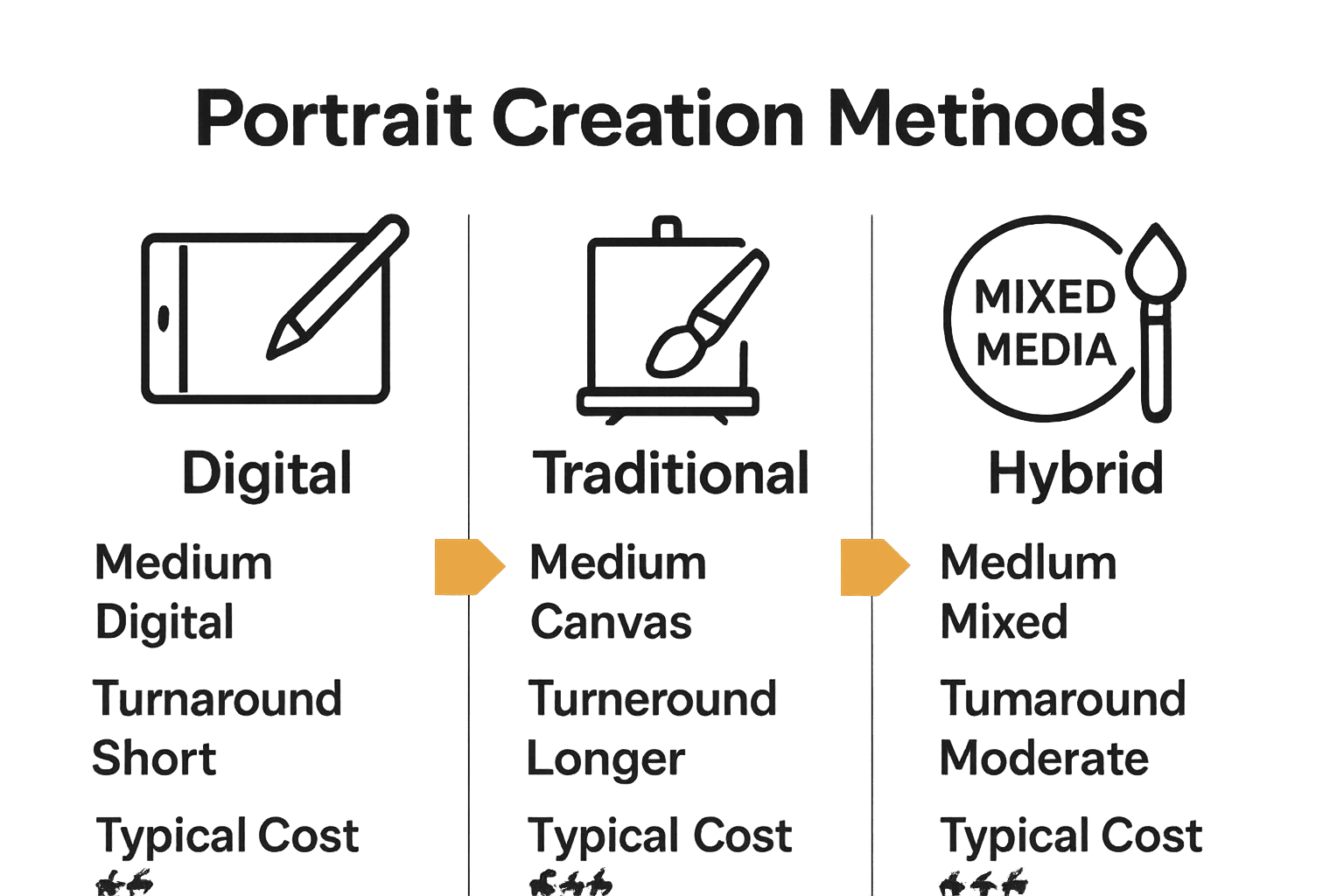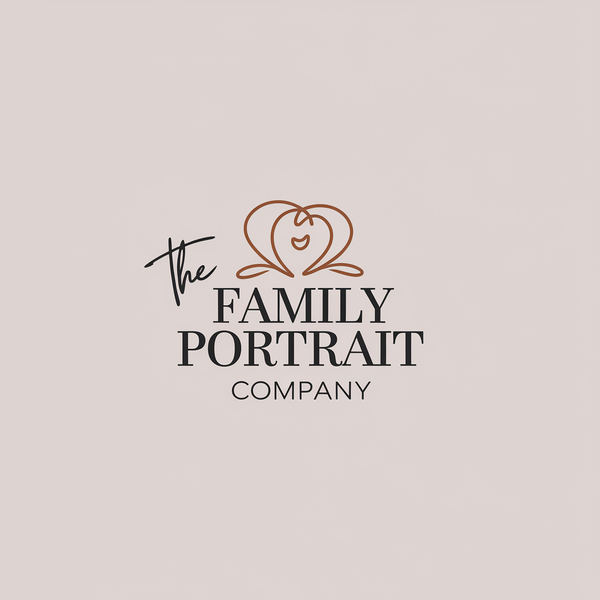
Portrait Creation Process: Everything You Need to Know
Partager
Nearly half of today’s portraits never touch a paintbrush, blending digital finesse with timeless artistry instead. Portrait creation matters more than ever, whether you want to capture personality for a family heirloom or craft a striking professional image. With technology and tradition now working side by side, understanding the modern portrait process helps you find the style, workflow, and results that truly celebrate your individuality.
Table of Contents
- Defining The Modern Portrait Creation Process
- Exploring Popular Styles And Techniques
- Step-By-Step Commissioning And Workflow Explained
- Turnaround Times, Costs, And Deliverables
- Common Pitfalls And How To Avoid Them
Key Takeaways
| Point | Details |
|---|---|
| Evolving Techniques | Modern portrait creation combines traditional skills with digital innovation, enhancing artistic possibilities. |
| Collaboration is Key | Successful portrait commissions rely on clear communication and mutual understanding between clients and artists. |
| Understanding Costs and Timelines | Factors such as medium complexity and artist workload significantly influence turnaround times and pricing. |
| Avoiding Common Pitfalls | Careful photo selection and maintaining open dialogue can prevent issues and ensure satisfactory portrait results. |
Defining the Modern Portrait Creation Process
Portrait creation has evolved dramatically from traditional techniques to a dynamic blend of artistic skill and digital innovation. Today’s portrait process integrates classic observational methods with cutting-edge technological approaches, transforming how we capture and immortalise personal images.
Traditionally, portrait creation required meticulous hand skills and in-person observation. According to City Lit, classic techniques focused on precise skills like understanding head proportions, mastering rotation techniques, and developing nuanced observational painting methods. These foundational skills remain crucial in contemporary portrait making, providing the technical backbone for creating compelling visual representations.
Modern portrait creation now embraces digital technologies that expand artistic possibilities. As Arts University London highlights, contemporary portrait makers integrate advanced tools like Adobe Photoshop, sophisticated digital camera settings, and professional lighting techniques. This technological integration allows for unprecedented creative flexibility, enabling artists to:
- Manipulate lighting and shadows with precision
- Experiment with digital editing techniques
- Capture intricate details impossible in traditional mediums
- Create personalised portraits across various styles and formats
The modern portrait creation process is no longer confined to a single medium or approach. Choosing the Best Portrait Photo Guide represents this evolution, showcasing how personal photography, digital illustration, and traditional painting techniques can seamlessly intersect to produce stunning, emotionally resonant portraits that capture individual essence with remarkable depth and authenticity.
Exploring Popular Styles and Techniques
Portrait creation offers a rich tapestry of styles and techniques, each bringing unique artistic expression and emotional depth to visual representations. From traditional realism to contemporary digital interpretations, artists and photographers have developed diverse approaches to capturing human essence.
Here’s a comparison of popular portrait styles and their main characteristics:
| Style | Traditional Techniques | Digital Approaches |
|---|---|---|
| Realistic Portraiture | Precise proportions Nuanced observation |
High-res digital detail Advanced retouching |
| Impressionistic Portrait | Loose brushstrokes Vivid colours |
Digital brushes Expressive filters |
| Mixed Media | Oil or acrylic paint Pencil |
Digital collage Layer blending |
| Stylised Portrait | Caricature Abstract forms |
Graphic effects Personalised filters |
| Augmented Reality | Not applicable | Interactive elements 3D features |
Realistic Portraiture remains a foundational style, emphasising precise anatomical details and nuanced emotional rendering. This technique requires exceptional observational skills, focusing on capturing exact facial proportions, subtle skin textures, and intricate light interactions. Realistic portraits aim to create an almost photographic representation that reveals the subject’s inner character through meticulous visual translation.
In contrast, Impressionistic Portraits take a more interpretive approach. These styles prioritise emotional resonance over literal representation, using loose brushstrokes, vibrant colour palettes, and abstract elements to convey mood and personality. Artists deliberately blur precise details, allowing emotional interpretation to emerge through expressive technique.
Digital technologies have revolutionised portrait creation, introducing innovative styles like:
- Digital Illustration Portraits: Blending photographic elements with graphic design
- Mixed Media Portraits: Combining traditional painting with digital manipulation
- Stylised Digital Portraits: Using software to create highly personalised, artistic interpretations
- Augmented Reality Portraits: Incorporating interactive digital elements
Understanding the Custom Portrait Creation Process exemplifies how modern techniques transform personal imagery, allowing individuals to select styles that most authentically represent their unique identity and emotional landscape.
Step-By-Step Commissioning and Workflow Explained
Commissioning a portrait is an intimate and personalised journey that transforms a simple photograph into a cherished artwork. The process involves careful collaboration between the client and the artist, ensuring that the final piece captures not just a physical likeness, but the essence of an individual’s personality and spirit.
Royal Society of Portrait Painters highlights the importance of understanding the nuanced commissioning process. The workflow typically begins with an initial consultation where clients discuss their vision, preferred style, and specific requirements. This crucial first step allows artists to gauge the emotional and aesthetic expectations, setting the foundation for a successful portrait creation.

The comprehensive portrait creation workflow generally follows these key stages:
- Initial Consultation: Discussing artistic vision and expectations
- Photo Selection: Choosing the most suitable reference image
- Style and Medium Confirmation: Selecting portrait technique
- Draft and Sketch Phase: Creating preliminary artistic concepts
- Refinement and Feedback: Collaborative adjustment of portrait details
- Final Artwork Delivery: Presenting the completed portrait
The Portrait Photographer’s Manual emphasises that successful portrait commissions require clear communication and mutual understanding between the artist and client. Professional artists typically provide multiple draft versions, allowing clients to provide feedback and ensure the portrait meets their emotional and aesthetic expectations.
Portrait Process Explained: Complete Guide further illustrates that modern portrait creation is a collaborative, personalized experience. Clients are encouraged to be actively involved throughout the process, ensuring the final artwork truly represents their unique story and emotional landscape.
Turnaround Times, Costs, and Deliverables
Understanding the financial and temporal investment in portrait creation helps clients set realistic expectations and make informed decisions. The complexity of portrait creation involves multiple factors that directly influence pricing, delivery timelines, and final artistic output.
City Lit highlights that portrait creation is a nuanced process requiring significant artistic expertise. Turnaround times can vary dramatically depending on several critical factors:
- Artistic Medium: Digital illustrations typically complete faster (1-2 weeks) compared to hand-painted portraits (4-8 weeks)
- Complexity of Design: Simple headshots require less time than full-body or multi-subject compositions
- Artist’s Current Workload: Established artists might have longer waiting periods
- Revision Requirements: Additional refinement stages extend overall project duration
Arts University London emphasises that professional portrait creation involves sophisticated technical processes that impact cost structures. Pricing typically ranges across these categories:
- Basic Digital Portrait: £100 - £300
- Intermediate Detailed Portrait: £300 - £750
- Premium Custom Artwork: £750 - £2,000
- Commissioned Fine Art Portrait: £2,000 - £5,000
Choosing the Best Portrait Photo Guide recommends clients discuss deliverables upfront. Standard deliverables usually include:

- High-resolution digital file
- Professional printing options
- Framing recommendations
- Certificate of authenticity
- Digital proof for client approval before final production
Common Pitfalls and How to Avoid Them
Portrait creation can be a delicate process fraught with potential challenges that can derail the entire artistic endeavour. Understanding these common pitfalls helps clients and artists navigate the creative journey more effectively, ensuring a successful and satisfying portrait experience.
Photo Selection represents the first critical stage where many individuals encounter challenges. Choosing an inappropriate reference image can compromise the entire portrait’s quality. Ideal reference photos should:
- Have clear, high-resolution details
- Showcase natural lighting
- Capture genuine facial expressions
- Provide multiple angles if possible
- Represent the subject’s true essence
Communication breakdowns frequently emerge as another significant obstacle in portrait creation. Misaligned expectations between the artist and client can lead to frustration and unsatisfactory results. Understanding the Custom Portrait Creation Process suggests implementing these strategic communication techniques:
- Provide Detailed Initial Brief: Clearly articulate your vision
- Request Initial Sketches: Review preliminary concepts
- Establish Clear Revision Protocols: Define number of potential changes
- Maintain Open Dialogue: Regular check-ins during creation
Technical limitations can also impact portrait quality. Clients should be aware of potential issues such as:
- Poorly sourced photographic references
- Unrealistic stylistic expectations
- Limited artistic mediums
- Colour reproduction challenges
- Complexity of capturing emotional nuance
Choosing the Best Portrait Photo Guide emphasises that proactive communication and realistic expectations are the most effective strategies for avoiding portrait creation pitfalls. By understanding potential challenges in advance, clients can collaborate more effectively with artists to create truly memorable portraits.
Bring Your Portrait Vision to Life with Expert Custom Creations
Navigating the complexities of the portrait creation process can feel overwhelming when you want to capture your true essence or your pet’s unique personality. This article highlights common challenges like selecting the perfect photo, aligning on style, and embracing collaborative feedback. At The Family Portrait Company, we understand the emotional journey behind commissioning personalised artwork and the importance of seamless communication to avoid pitfalls.

Explore our range of custom pet and human portraits on our Home page – The Family Portrait Company. Whether you seek a realistic portrayal or a more stylised expression, our expert artists guide you through each step from photo selection to final delivery. Don’t wait to treasure your memories in a beautiful portrait crafted to reflect your unique story. Visit https://familyportraitcompany.com today and start your personalised portrait journey with confidence.
Frequently Asked Questions
What is the modern portrait creation process?
The modern portrait creation process combines traditional artistic skills with digital technology. It involves observational methods alongside tools like Adobe Photoshop and advanced camera settings, allowing for greater creative flexibility.
How long does it typically take to create a portrait?
Turnaround times for portraits can vary significantly depending on the artistic medium and complexity. Digital illustrations may take 1-2 weeks, whereas hand-painted portraits could take 4-8 weeks.
What factors influence the cost of commissioning a portrait?
The cost of commissioning a portrait depends on various factors including the artistic medium (digital vs. traditional), the complexity of the design, the artist’s workload, and any revision requirements. Prices can range from £100 to over £5,000.
What are the common pitfalls in portrait creation and how can they be avoided?
Common pitfalls include selecting poor reference photos, communication breakdowns with the artist, and technical limitations. Clients can avoid these issues by providing detailed briefs, maintaining open dialogue with artists, and setting realistic expectations.
Recommended
- Portrait Process Explained: Complete Guide (UK) – The Family Portrait Companys
- Step-by-Step Portrait Ordering Process 2025 Guide – The Family Portrait Companys
- Choosing the Best Portrait Photo for Stunning Results – The Family Portrait Companys
- How to Order Custom Portraits from Your Photos Easily – The Family Portrait Companys
